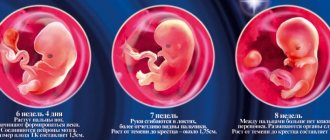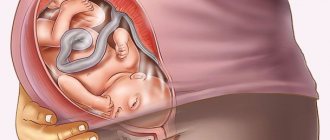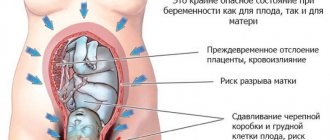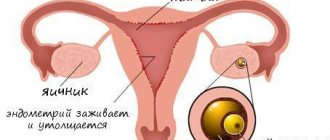After crossing the 37-week mark of pregnancy, the baby developing in your tummy is considered full-term. This means that until the end of this week you must treat your health with caution - let it grow.
The task assigned to your body is almost completed, all that remains is to give birth. By this moment, all the main close-ups must be completed - the child’s room has been prepared, a crib and stroller have been purchased, things for the maternity hospital have been collected, a course of lectures has been completed.
Put off long trips; in the last weeks of pregnancy it is better not to go far from home - childbirth may catch you at the most inopportune moment.
Fetal development
The baby is just waiting in the wings - he is fully matured and the 37th week is needed only for the finishing touches - he continues to gain weight.
The baby's skin is pink, covered with lanugo only in the area of the shoulder blades and lower back. The hair on the head continues to grow, and by the time your miracle is born, it may have thick hair.
This is what your baby looks like at 37 weeks
The fingernails already extend beyond their edges, and the child can scratch himself.
Subcutaneous fat is deposited, especially in the face area, making the cheeks plump and the baby very cute.
Now your baby looks like a newborn.
The functioning of the brain improves, reflexes become stable - the sucking reflex is most pronounced, the baby sucks his finger during all his free time from sleep - this is how he prepares to receive food from your breast.
The child actively reacts to everything that happens, and the mother can even understand whether her child likes something or not.
The visual and auditory systems have fully matured, the child is ready to perceive and process information. Already now he hears, remembers and distinguishes the voices of his parents, the music that his mother listens to.
The child moves less and less - there is not enough space for him, and he only makes kneading movements.
Dietary rules for a woman at 37 weeks of pregnancy
The 37th week of pregnancy should be accompanied by proper nutrition. Nutrition should be complete, rational, balanced in proteins, fats and carbohydrates. A pregnant woman should receive the entire necessary set of vitamins and minerals from food.
At the 37th stage of pregnancy, expectant mothers should follow these simple recommendations:
- Limit the consumption of salty, smoked and spicy foods.
- Eat small portions, which helps facilitate the process of digestion and absorption of food.
- It is advisable to take dairy products 2 hours before going to bed to effectively prevent constipation. Dairy products are excellent sources of calcium. With this intake, calcium is absorbed better than when taking drugs from the pharmacy chain.
- Eat enough iron. This microelement is found in buckwheat porridge, pork and beef liver.
- Replenish the water-salt balance by drinking at least one and a half liters of clean water daily.
From the digestive system at 37 weeks of pregnancy, the following unpleasant sensations may occur: heartburn, constipation, pain in the right hypochondrium, flatulence.
Ultrasound at 37 weeks of pregnancy
Most often, ultrasound is prescribed at this time for women whose baby was in an incorrect position. It is clarified whether the child “changed his mind” and turned over.
In addition, this study determines the blood flow in the placenta, the size of the fetus, the degree of maturity of the placenta, and the amount of amniotic fluid.
Childbirth at 37 weeks of pregnancy: harbingers
Abdominal prolapse
The belly gradually drops lower, making it easier for the mother to breathe, but some women do not wait until the birth itself. The lower the child goes, the more you will feel shooting pains in the perineum and legs. At the same time, pressure on the bladder and intestines increases - you will notice that you start running to the toilet more often. Closer to birth, the baby becomes quieter and his activity noticeably decreases.
Removal of the mucus plug A few days or even weeks before the onset of labor, the mucus plug comes off, but this is not at all necessary. The release of the mucus plug will be indicated by the appearance of thick, viscous mucus in the discharge. These are particles of the mucous plug that closes the cervix before birth. The mucus discharge can be either transparent or pinkish, tinged with brown, interspersed with blood.
Energy boost
If the last weeks of pregnancy were given to you with noticeable difficulty, then shortly before giving birth you may find that you have a “second wind”. You were tormented by fatigue and powerlessness, and now you are ready to move mountains and walk around in a great mood, full of strength and desire to do something? Rest assured - childbirth is already on the threshold.
Loss of weight and appetite
If the middle of pregnancy is marked by excellent appetite, then by the end of pregnancy this same appetite may decrease significantly. Moreover, 3-4 days before giving birth, some women even show their readiness to completely give up food; they don’t feel like eating at all. As for weight, some women may notice a weight loss of 1-2 kg shortly before giving birth.
Outpouring of waters
The breaking of water can occur both against the background of contractions, and shortly before their onset. In any case, if you notice streams of watery liquid crawling down your legs, but the uterus is not yet contracting spasmodically, either go with your husband to the hospital or call an ambulance. The rupture of amniotic fluid always indicates the onset of labor.
Diarrhea
In some cases, pregnant women may experience diarrhea on the eve of childbirth. If suddenly, against the background of complete well-being, you begin to experience diarrhea, perhaps within a day or two you will find yourself in the maternity hospital with contractions.
Nagging pain in the abdomen and lower back, contractions
Painful sensations in the lower abdomen, spreading to the lower back, will also tell you about the approaching birth. The pain in the abdomen and lower back is similar to that which a woman experiences on the eve of her period.
More on the topic
What to do if labor does not begin at 40-41 weeks?
Pain in the lower abdomen during pregnancy
How many days before giving birth does the belly usually drop and what does it depend on?
Stitching pain in the lower abdomen during pregnancy
What to do if you have a small belly during pregnancy and it doesn’t grow?
But, probably, the most obvious and “categorical” harbinger of childbirth is regular painful contractions. You have already become familiar with training contractions over the previous few weeks, and you know that Braxton-Higgs contractions are irregular and do not cause pain. Therefore, if you suddenly notice that the uterus has begun to contract with a certain frequency, the contractions are becoming more frequent, strong and painful, then it is time to leave for the maternity hospital.
What happens in your body at 37 weeks?
Most expectant mothers are already tired by this time. They want to give birth faster, see their baby, hold him in their arms, put him to their chest.
The stomach may drop, and the problems of heartburn and shortness of breath will cease to bother you, but others may appear - frequent urination, the urge to defecate.
Training contractions continue, their frequency may increase slightly - most pregnant women already know how to cope with them by the 37th week, the main thing is not to confuse them with real ones
You may stop gaining weight - this is also one of the signs of impending labor.
Baby at 37 weeks
It is the 37th week of pregnancy that finally completes the process of preparing the child to enter the “big world”. Every day the baby's weight increases by an average of 30 grams, so at this time the mother especially needs a support bandage that will not put too much pressure on the abdomen. Although the fetal nervous system is already functioning, at this time a protective sheath is formed around the nerves. This process will not be completed during life inside the mother, but will continue for several months after birth. After the final formation of the nervous system, the child’s movements will become much clearer and more confident.
The changes also affect other body systems. For example, the 37th week of pregnancy is characterized by the fact that the cartilage in the baby’s ears and nose becomes much harder. The head is covered with hair, the length of which can reach 5 centimeters. Outwardly, the child is already very similar to a baby, his skin is smoothed out, and the primary fluff has already completely disappeared. Sometimes the skin is still covered with vernix, but usually by 37 weeks of pregnancy it remains only in folds.
Baby at 37 weeks
During this period, the baby is a smaller copy of an adult; a small amount of black feces has already accumulated in his intestines, although the skull has not yet fully formed. This is because during the birthing process the bones of the skull must move slightly together, otherwise the baby's head will not be able to pass through the mother's pelvis. The formation of the skull is completed several months after birth.
The 37th week of pregnancy is especially important because at this time the hormone cortisone is produced in sufficient quantities, which is responsible for the readiness of the lungs to begin working independently. It is precisely because of its absence in the child’s body that premature birth is undesirable, since the lungs cannot yet provide the child with the necessary amount of oxygen. In addition, at this time the child’s adrenal glands begin to produce a special hormone that will reduce the child’s stress upon birth.
How you feel at 37 weeks
Don’t be irritated for no reason - the desire to give birth faster is inherent in many people, and from now on it will only increase. There is no need to rush time - the baby himself knows when it is better for him to see the light. If questions from others about your upcoming birth make you feel negative, take up auto training and spend more time among those who know and support you.
When the abdomen lowers, the child will approach the entrance to the pelvis and the pressure on the surrounding tissues will decrease - this will manifest itself as a feeling of relief.
You feel the baby's kicks less often, but more painfully. Sometimes there is a feeling of numbness in the limbs, which is associated with impaired microcirculation in the vessels.
What's happening to the baby
At the thirty-seventh week, the baby continues to gain weight , which is already about 3 kg. The child's height is 49 cm, and the diameter of the head is 90 mm. If the baby's size is significantly larger than average, then obstetricians can induce labor to avoid complications. In some cases, with a large fetus, a planned caesarean section is performed.
The child is fully matured and ready to be born at any moment. Its thermoregulatory system is able to cope with temperature changes, although peripheral microcirculation may suffer from cold. It is optimal if the room is about 280C. During the first month after birth, it is advisable to keep the baby's feet warm.
Hair on the head and nails on the fingers and toes continue to grow. They are very thin and sharp, and due to their tiny size, it can be difficult to trim them.
To prevent the child from accidentally scratching himself, some pediatricians recommend wearing special cotton mittens . It is advisable not to do this, since during this period the child learns about the world around him mainly through touch. By limiting its tactile sensations, its development can be somewhat slowed down.
The placenta is in the stage of binding, its diameter is 35 mm. Ultrasound can detect a slowdown in uteroplacental blood flow and the presence of calcifications and other signs of aging. If signs of fetal hypoxia and insufficient nutrition are detected, then obstetricians stimulate labor.
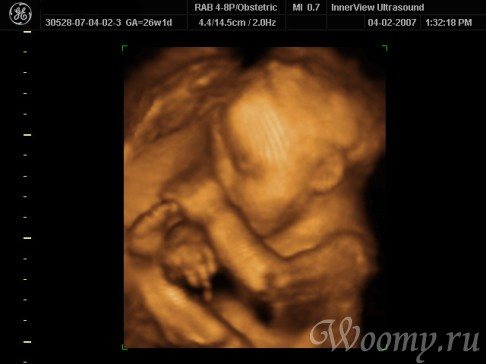
Photo of an ultrasound of a child at 37 weeks of pregnancy
Discharge from the genital tract
At this time, the usual light discharge is mixed with mucus, which may contain a small amount of blood streaks. This is a mucus plug, which throughout pregnancy served as a barrier to the penetration of infection to the child. It begins to come off in small amounts 2 weeks before giving birth.
Purulent discharge must be eliminated as soon as possible - infection during childbirth is dangerous for both mother and child.
Bloody discharge is a reason to seek help, especially if it was preceded by an injury, a fall and is accompanied by pain.
Belly at 37 weeks of pregnancy: tugs, hurts, droops
If abdominal drooping did not occur in the previous week, it is quite possible that this will happen now, at 37 weeks of pregnancy. If this does not happen now, do not worry: in some cases, the stomach does not drop until the very end of pregnancy.
But if, nevertheless, the stomach drops, do not expect that labor will begin almost immediately: after the stomach drops, the woman can easily carry the baby for another 1-2 weeks. But when you inhale and exhale freely, your lowered stomach allows you to breathe easily.
But, instead of difficulty breathing, pain may appear in the lower abdomen, also affecting the lower back. Drawing, tolerably painful sensations in the lower abdomen, if such sensations are also present in the lumbar region, are one of the harbingers of childbirth, a sure sign that very soon the baby will begin his journey into a new world.
Photos of bellies at 37 weeks
Pain at 37 weeks of pregnancy
So, what can explain abdominal and lower back pain at 37 weeks of pregnancy, we found out above. Aching, nagging pain is a consequence of the lowering of the abdomen and a sign of impending labor.
Surely, pain in the back, spine, sacrum, and legs is still relevant. The fact of increased weight, an enlarged uterus and, accordingly, abdomen does not go unnoticed. Try to rest more, from time to time take a horizontal position, placing a bolster or pillows under your feet, do not forget to wear a prenatal bandage, unload your legs.
You will have to endure pain in the pelvic region, in the sacrum, in the pubic bone - not only do the pelvic bones weaken and separate under the influence of the hormone relaxin, but the baby also puts pressure on the fundus of the uterus. There is less and less time left before giving birth, but all this time you may well be accompanied by this painful discomfort in the lower part of the body.
Risks at 37 weeks
The main danger at this stage is the development of gestosis and its transition to eclampsia. The condition can develop if your body cannot cope with the load and kidney function is impaired. The earliest and reversible manifestations are edema, increased blood pressure and protein in the urine. If symptoms are left unattended, the condition worsens and develops into preeclampsia. It is manifested by flashing “spots” before the eyes, impaired consciousness, headache, and dizziness. If you feel unwell, the main thing is to call an ambulance.
Another danger is premature placental abruption, a condition that can lead to large blood loss, fetal hypoxia and even death. Manifested by severe abdominal pain and bloody discharge.
For women whose previous births ended by caesarean section, there is a danger of uterine rupture along the old scar, so any pain in the abdomen should not be overlooked.
Fetal development at 37 weeks
Babies in the womb are now comparable in size to a head of Brussels sprouts . Their bodies at this stage are not configured to increase growth, but to accumulate adipose tissue. This will help them maintain thermal balance after birth.
Dimensions of twins at 37 weeks of pregnancy:
- Head circumference: 337 mm
- Tummy circumference: 330 mm
- Thigh length: 70mm
- Weight: 2660 g
- Height: 46.9 cm
Babies should now be in the correct position - pelvic - if you are planning a natural birth. If at least one fetus is not lying correctly, then you will be operated on by caesarean section .
Important at 37 weeks
Attend your antenatal clinic regularly and follow all your doctor’s orders. If you don’t know which maternity hospital you will give birth in, it’s time to find out, meet the doctor, and discuss the possibility of labor pain relief.
It would be a good idea to educate yourself - learn the basic principles of breastfeeding and caring for your baby. Purchase all the necessary tools for this.
At week 37, you need to completely abandon the bandage. The baby needs time to descend closer to the entrance to the pelvis, and the bandage can hold him and delay the time of birth indefinitely.
Signs of imminent labor:
- the stomach sank, breathing became easier, heartburn tormented less often;
- the mucus plug has come off in a large clot - a colorless or yellowish clot of mucus with slight streaks of blood;
- signs of indigestion have appeared - the intestines are cleaned so that nothing interferes during childbirth.
The development of contractions or the release of amniotic fluid is the beginning of labor, and not a harbinger and indicates that it is time to go to the maternity hospital.
Childbirth at 37 weeks
In the absence of pathological phenomena, the child’s body is prepared for release into the world. The nervous system will also not be affected; the neural connections surrounded by tissue will not react to changing conditions; this will not affect them in any way. The baby’s central nervous system will continue to change and strengthen during the first 12 months.
The baby's lungs are also ready to breathe in the air space, thanks to the produced surfactant. A newborn will breathe on its own within moments of birth. The fetus is so developed that it fully corresponds to the time of birth. The birth process can begin on any day of the 37th week, and for those carrying twins or giving birth again, this birth date is considered the norm.
But you need to understand that a strong push from a baby or a single contraction is not a reason to immediately run to the maternity hospital. You should monitor birth harbingers and not lose sight of various features and little things.
You need to go to the maternity hospital if several signs are present:
- repetition of contractions every five minutes;
- severe pain during contractions;
- reducing the intervals between contractions.
Don’t be afraid to have a light meal before going to the maternity hospital, you will need strength and you need to support it. Breathing exercises and walking will help you ease your condition. The pain will be more noticeable if you do not move.
37 weeks is considered favorable for childbirth. The well-being of the birth process at 37 weeks is ensured by nature itself. Mother and child are prepared, the placenta has fulfilled its function and is aging, ceasing to provide the fetus with the substances necessary for life. At this moment, the woman begins to produce a hormone designed to naturally stimulate initial and subsequent attempts.
The main thing for a woman is to be psychologically prepared for childbirth. Throughout the entire period of bearing a child, you need to remember that childbirth is not a simple, but natural process. Typically, pregnant women are prepared at the antenatal clinic for childbirth; many attend special courses and learn ways to alleviate the condition during labor.
Remember that the mood of the mother in labor is transmitted to the child; panic fear can harm both the pregnant woman and the baby. The key to a successful birth is strict adherence to the instructions of the obstetrician.
This is especially true for behavior in the prenatal ward and delivery room. If you comply with the requirements of the medical staff, then everything will work out with minimal or no disruption. The pain will be forgotten, and the happiness from the birth of a child will be remembered for a lifetime.
What complications can occur at 37 weeks of pregnancy?
Your baby's bones and nails continue to grow, which requires calcium. It is also necessary for the pregnant woman herself to prevent the development of hemorrhoids and varicose veins.
Equally important is the regular supply of vitamin D to the body, which will prevent the development of rickets in a child.
In addition, a woman should monitor her weight. Rapid gains are dangerous. So, if the fetus is large, this increases the risk of injury to the child during passage through the birth canal. This threatens a woman with numerous breaks.
The main danger in late pregnancy remains eclampsia. It is the leading cause of death among pregnant women worldwide. This also applies to developed countries. Eclampsia does not occur instantly; it is always preceded by preeclampsia. It is important not to ignore the first signs of impending toxicosis.
If the child is in a breech position, then at this stage it will no longer be possible to change his body position. In this case, the woman will be hospitalized until labor begins, after which the issue of a caesarean section will be decided.
Baby at 37 weeks
The baby's gestation period is coming to an end. Baby at 37 weeks of pregnancy
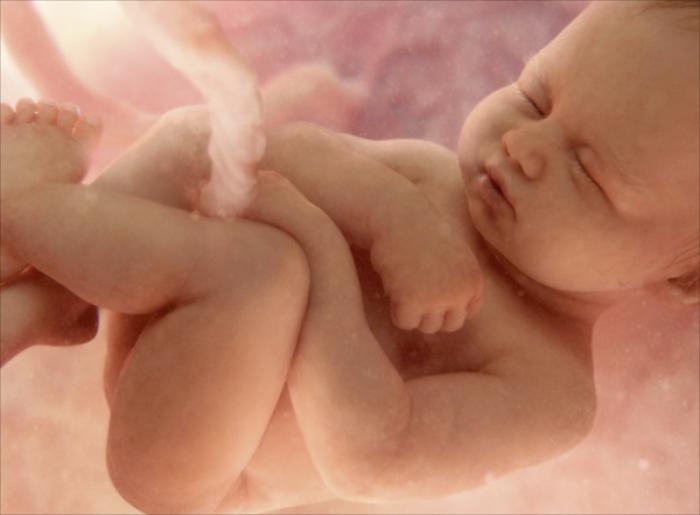
already fully prepared for birth. The small body produces hormones that prepare the newborn for existence outside the womb. The 37th week of pregnancy is the time when the necessary amount of iron accumulates in the fetal liver, which can provide the baby with blood cells during the first year of his life. During this same period, a hormone begins to be produced that is responsible for the maturation of the baby’s lungs. Special substances are also produced that help reduce the effects of stress after childbirth. This is necessary for both the baby and the mother in labor.
The 37th week of pregnancy is also characterized by the improvement of all vital systems of the fetus. Some processes will continue in subsequent weeks of pregnancy. The main ones will be completed only when the child reaches one year of age. Neurons develop rapidly and are enveloped in a special membrane that has a protective function. This is necessary for the development of coordination of movements of a small person.
The 37th week of pregnancy is also difficult for mothers. The baby's movements become more and more active. He no longer has enough space in his mother’s womb and wants to be born. But the birth process will begin only when both mother and child are ready for it. Premature birth can lead to birth injuries and non-expansion of the lungs. Therefore, the 37th week of pregnancy is not considered suitable for planned induction of labor.
Particular attention should be paid to the movements of the baby in the womb. The baby's movements can be perceived by the mother as quite painful. But the absence of tremors should be alarming. If the child does not remind himself for a long time, you should immediately consult a doctor.
The fruit also grows significantly in size. The amount of adipose tissue increases. It is quite difficult for those women who are at 37 weeks of pregnancy. The child's weight already reaches almost 3 kg. In addition, the amount of amniotic fluid and blood volume increases. The total weight gain of a woman can reach 15 kg.
Childbirth at the 37th week of pregnancy, occurring naturally, usually occurs without problems. The baby already has a good body weight, can breathe independently and suck on the mother's breast. During this period, cartilage tissue hardens. But the bones of the skull remain soft. Thanks to this, the fetus can easily pass through the mother's birth canal.
What should you be wary of at 37 weeks of pregnancy?
During a normal pregnancy, a woman should feel well even in the last stages, provided that she follows the doctor’s recommendations. But carrying a baby does not go smoothly for everyone. The presence of some symptoms may indicate the manifestation of late toxicosis. Headache, muscle twitching, and spots before the eyes should alert you. If you experience pain in the upper abdomen at 37 weeks of pregnancy, you should consult a specialist immediately.
Preeclampsia is quite dangerous in late pregnancy. This is a pathological condition that can be fatal if you do not seek medical help in a timely manner. The manifestation of gestosis may be primarily indicated by a high content of protein in the urine, as well as severe swelling of the extremities. Temperature at 37 weeks of pregnancy is also a bad sign. It can speak of both late toxicosis and the beginning of the inflammatory process.
In the later stages of gestation, all systems of the expectant mother work to their limits. This can also lead to worsening chronic diseases. A pregnant woman should be observed by a specialist in her disease and not hide alarming symptoms. Indeed, during this period it is worth taking care not only of your health, but also of the condition of the fetus. In this way, possible complications during childbirth can be avoided.
Discharge at 37 weeks of pregnancy
Don't be alarmed if you suddenly notice a slight increase in discharge at 37 weeks of pregnancy - this is quite normal now. Also, you should not be alarmed by the presence of mucus in the discharge: this is the mucus plug being separated. Normally, stringy mucus in the discharge, if it is particles of a mucus plug, may have a whitish, pinkish or brownish tint. The cork can also separate at once - in one solid lump, reminiscent of jelly or silicone. You will definitely recognize a mucus plug: this lump has a volume of approximately 2 tablespoons, and there may be bloody streaks in the lump. Having discovered a mucus plug, you can safely go to the maternity hospital - labor will begin very soon.
If the discharge takes on an unhealthy earthy hue, the mucus resembles the consistency of purulent formations, the discharge becomes green or yellow, curdled or foamy - immediately go to the doctor for diagnosis. A change in discharge in this direction indicates the development of an infection, which must be treated before birth so as not to “share” the infection with the baby when he travels through the birth canal.
Do not hesitate to call an ambulance if you find yourself bleeding. Blood from the genital tract most often becomes a sign of detachment of a normally located placenta - placenta previa, which is also accompanied by bleeding, has probably already been ruled out after undergoing many studies and tests. Please note that placental abruption is a very dangerous phenomenon that threatens the life of the child.
Again, you should contact doctors or go to the maternity hospital if you notice the discharge of amniotic fluid. Amniotic fluid can flow out all at once - you will know about its appearance by the trickles running down your legs. Which, in fact, precede the onset of labor. But, at the same time, amniotic fluid can leak in small quantities, in portions - if the membranes are depleted or their integrity is compromised. And in this case, it is again impossible to do without the intervention of specialists: violation of the integrity of the membranes threatens intrauterine infection of the fetus.
What should you do at 37 weeks of pregnancy?
Childbirth at 37 weeks of pregnancy can begin at the most inopportune moment. Therefore, the expectant mother must be fully prepared for the long-awaited event.

The first thing you need to do is choose a maternity hospital and agree with the doctor who will deliver the baby into the world. You can pay for your stay in the postpartum ward in advance. After all, after the birth of a child, there will be even more worries. The doctor’s phone number must be written down in several copies, and relatives must also be informed.
The 37th week of pregnancy is also suitable for packing things for the maternity hospital. The list of necessary medications can be checked with the doctor who is caring for the pregnancy. You also need to pack a separate bag with bedding, clothing and personal hygiene products. Don't forget about your camera and video camera. The first minutes of a baby’s life should definitely be captured.
You need to prepare things for the newborn in advance. You shouldn’t buy too many clothes for the maternity hospital. Babies grow very quickly. Therefore, a few blouses, caps, rompers and pairs of socks will be quite enough. Determining clothing size is very difficult for primiparous women who have begun the 37th week of pregnancy. The child’s weight and height are the main indicators from which to build. If the baby develops normally, then the expectant mother can purchase clothes for a newborn with a height of 56 cm. The same principle should be used to purchase diapers for the maternity hospital.
Immediately after birth, the baby should not be bathed completely. Full water procedures will be carried out only after the umbilical cord falls off and the wound has healed. Special wet wipes for babies will come to the rescue. You can buy them at almost any pharmacy. The maternity hospital should buy several packages of such napkins at once. They will also be useful for the mother in labor.
Baby activity at 37 weeks of pregnancy

Your baby at this stage
At this stage of the perinatal period, the fetus is considered to be completely ready to be born. Especially if you are pregnant with many children, then this is exactly the week when you should expect the appearance of your babies. The embryo acquired flesh-colored pink skin, hair, and subcutaneous fat. The digestive tract is completely ready to adapt to the outside. The cartilage and bones have become quite strong. The baby becomes as large as possible in size, weight, and occupies all the space in the mother’s belly.
Baby's movements
When the 37th week of pregnancy arrives, the baby stops actively moving, which is due to the following reasons:
- It is large in size and occupies all the space in the mother's abdomen. This prevents him from rolling over, which reduces motor manifestations.
- The child sleeps almost all the time.
- If the mother takes soothing tea, she is at rest and barely noticeable movements are also noted.
This situation should not frighten mothers. Dangerous cases are when the fetus has completely stopped pushing or is hyperactive - you should seek help from a gynecologist. He will determine the cause of the condition and rule out pathologies.
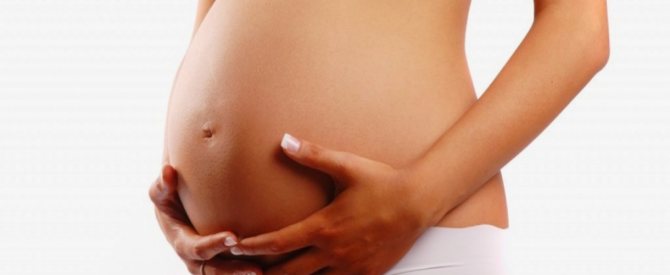
Listen carefully to your well-being and the condition of your child. If you have any concerns, contact your doctor immediately to avoid the point where the process may be irreversible.
Scheme for calculating normal fetal movements
There is a special scheme that helps mothers determine the condition of their own baby.
Doctors recommend starting the countdown from the onset of the third trimester daily, which will help track normal development and functioning. How to check:
- Time reporting must begin at 9 am.
- Enter into the table the exact time up to the minutes of the test start.
- Take into account the slightest movements, jolts, when the child turns over, kicks.
- When you have counted exactly 10 movements, write down the end time of the test.
- You may not continue the test until the next day.
Some recommendations:
- If at the 37th week of pregnancy the fetus moves little , this is not considered a sign of abnormal development, but we recommend visiting the hospital.
- When no changes occur within 1-3 hours, this may indicate that your child is resting and there is no need to worry.
- A critical case is lack of movement for 12 hours, even the smallest ones. You should immediately contact a gynecologist.
- If within 15-20 minutes you have fully counted 10 kicks, then your baby is quite active, there is no need to worry.
- When more than 10 sensations are observed in a short period of time, this can be negative.


